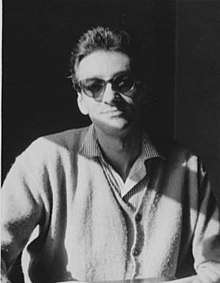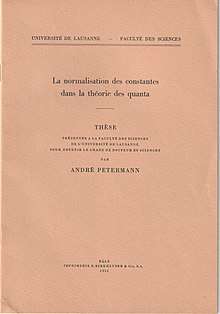André Petermann
Andreas Emil Petermann (27 September 1922, Lausanne, Switzerland – 21 August 2011, Lausanne), known as André Petermann, was a Swiss theoretical physicist known for introducing the renormalization group, suggesting a quark-like model, and work related to the anomalous magnetic dipole moment of the muon.[1]

Petermann obtained his doctorate from the University of Lausanne in May 1952[2][3] under the supervision of professor Ernst Stueckelberg. The work was funded by the Swiss Atomic Energy Commission.[4] Following Lausanne, Petermann moved on to the University of Manchester[5], UK, before he became a CERN staff member in 1955. The CERN Theory Division was at that time still hosted at the University of Copenhagen.[6] [7] It was then moved to Geneva together with the CERN experimental groups in 1957.[8]
Work

Jointly with his advisor, Ernst Stueckelberg, in 1953, they introduced, and named the "renormalization group", which describes the running of physical couplings with energy.[9][3] He also, apparently independently, considered the idea of quarks, albeit in a highly abstract, speculative form.[10] Petermann submitted a four-page paper entitled "Propriétés de l'étrangeté et une formule de masse pour les mésons vectoriels"[11] to the journal Nuclear Physics, which received the paper on 30 December 1963, but did not publish the article before March 1965. In this paper Petermann discusses what has become known as quarks as named by Murray Gell-Mann, whose Physics Letters publication[12] was submitted during the first days of January 1964, and "aces" as named by George Zweig, who wrote two CERN-TH preprints slightly later in 1964. [13] [14]
Petermann is also remembered for his pioneering calculation of the next-to-leading order correction to the anomalous magnetic dipole moment of the muon.[15]
Petermann was not consistent when signing his scientific papers; in the beginning of his career he used Petermann, then Peterman and later he alternated between the two forms.[16] A list of his works can be found in the INSPIRE-HEP Literature Database .
References
- Zichichi, Antonino (27 March 2012). "Interactions with André Petermann". CERN Courier. 52 (3): 24–25.
- Petermann, André (1952). La normalisation des constantes dans la théorie des quanta (PhD). University of Lausanne.
- Stueckelberg, E. C. G.; Petermann, A. (1953). "La renormalisation des constants dans la théorie de quanta". Helv. Phys. Acta. 26: 499–520. doi:10.5169/seals-112426.
- Aste, Andreas (19 May 2002). "E.C.G. Stueckelberg". Retrieved 10 April 2011.
- "Articles authored by Petermann in the Manchester period". INSPIRE HEP. CERN. Retrieved 6 November 2019.
- "Das Jahr 1955 Der Berner Relativitätskongreß und der Beitrag zur Bohr-Festschrift". Wolfgang Pauli. Sources in the History of Mathematics and Physical Sciences. 17. 2001. pp. see footnote at page 356. doi:10.1007/978-3-540-78805-8_1. ISBN 978-3-540-67591-4. ISSN 0172-6315.
- "25 years of service to CERN". CERN Bulletin (44/80): 1. 27 October 1989.
- Iliopoulos, J (1993). Physics in the CERN theory division (PDF) (Report). CERN. p. 6. CERN-CHS-39.
- Alvarez-Gaumé, Luis; Antoniadis, Ignatios; Ellis, John; Martin, André (20 February 2012). "André Petermann (1922 - 2011)". News-Obituary-Topic: At CERN. CERN. Archived from the original on 14 June 2019. Retrieved 14 June 2019.
- Petrov, Vladimir A. (2014). "Half a Century with Quarks". arXiv:1412.8681 [physics.hist-ph].
- Petermann, A. (1965). "Propriétés de l'étrangeté et une formule de masse pour les mésons vectoriels" [Strangeness properties and a mass formula for vector meson]. Nuclear Physics. 63 (2): 349–352. doi:10.1016/0029-5582(65)90348-2.
- Gell-Mann, M. (1964). "A schematic model of baryons and mesons". Physics Letters. 8 (3): 214–215. doi:10.1016/S0031-9163(64)92001-3. ISSN 0031-9163.
- G. Zweig (1964), "An SU(3) model for strong interaction symmetry and its breaking", In *Lichtenberg, D. B. ( Ed.), Rosen, S. P. ( Ed.): Developments In The Quark Theory Of Hadrons, Vol. 1*, 22-101 and CERN Geneva - TH. 401 (17 Jan. 1964) 24p.
- G. Zweig (1964), "An SU(3) model for strong interaction symmetry and its breaking II", Published in 'Developments in the Quark Theory of Hadrons'. Volume 1. Edited by D. Lichtenberg and S. Rosen. Nonantum, Mass., Hadronic Press, 1980. pp. 22-101 and CERN Geneva - TH. 412 (21 Feb. 1964) 76p.
- Petermann, A. (1957). "Magnetic Moment of the μ Meson" (PDF). Physical Review. 105 (6): 1931. doi:10.1103/PhysRev.105.1931.
- De Rújula, Alvaro (2019). "QCD, from its inception to its stubbornly unsolved problems". p. 5, see footnote at the end of section 4. arXiv:1910.13891 [hep-ph].